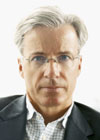
Marty Cooke is the chief creative officer of an agency called SS+K in New York City-but don't call it an ad agency. Marty's firm brings together a wide range of communications disciplines to provide what he calls "asymmetric communications." How does this work? We called Marty to talk about his agency's approach, and how language comes into play. Here's our conversation:
VT: First of all, tell us about your agency, SS+K.
Marty: We do a lot of advertising but we don't say we're an advertising agency. We reject that label. We were one of the first integrated shops with different disciplines -- advertising, PR, public affairs, marketing services, and more. Words like media agnostic could be applied to us, which is certainly true, but a lot of the stuff we do everybody's claiming now.
My background is advertising and when I was at an ad agency everybody I talked to on a daily basis was an ad person. They were really bright, interesting people but they were all kind of the same. Here we have advertising people, but we've also got PR people. We've got designers. We've got digital people. Our head of planning and strategy was a physicist at Harvard before she became a political pollster. Our head of design was a ballerina who danced with the American Ballet Theater around the world. We've got this very eclectic mix. Put this group around a table and you just don't know what you're going to get. It's pretty combustible, in a really good way. This is what we mean by asymmetric.
VT: Can you give us an example?
Marty: We did a project for Qwest a few years ago to sell mobile phones with a budget that was quite small. They thought we'd do a radio campaign because it was the obvious, but traditional way to reach the market size they wanted for the money. Instead, we produced a big urban game using a new technology that had never been used before. It worked. We also had a hand in the yellow band phenomenon for the Lance Armstrong Foundation, which is a really non-traditional way of approaching things. The great thing about my job is I just sit back and my people bring me all these amazing ideas.
VT: Do you see the advertising industry moving in this direction?
Marty: This company's about 14 years old and we were one of the first, if not the first, companies to put PR and advertising together under one roof. These were the two big pillars of the communications business back then. The market wasn't quite there yet, so we had PR accounts and ad accounts, and you couldn't sell a lot of PR to advertising accounts and vice versa. A few innovative larger agencies have since moved in this direction, and they're making the world safe for the smaller integrated agencies like us. Now in the last five to seven years a bunch of new agencies have popped up, mostly in New York for some reason, that are trying this model and trying to ride this new wave.
VT: Can you give us another example of your integrated approach?
Marty: Our Delta Airlines account is a great example. We have only about 100 people but Delta left a huge multinational agency to work with us. When we pitched Delta we really thought hard about the entire brand experience, in ways that might surprise you.
VT: Please explain.
Marty: We looked at all the touch points. So when we pitched Delta we talked about how they needed to repaint their planes, how they needed to redesign the terminals, how they needed to think about crowd movement. We talked to them about what food they served and the entertainment on the seat back screens.
VT: It seems that Delta went from dowdy to hip in the past year.
Marty: It wasn't just about the look, even the language was important.
VT: The language?
Marty: Yes. There's an old adage that goes "everything communicates." When you lose luggage, what kind of language does the airline use to apologize? We're trying to get their employees to react in a more human way. So we've had a hand in their staff orientation.
The bottom line is that you have to create a very distinctive voice for the brand. And you have to make the voice appropriate, in Delta's case, from an outdoor billboard to an on-board napkin.
VT: Can you explain this a little?
Marty: You have to ask, how does Delta's voice manifest itself when it's on television? How does it manifest itself online? It's tough because you have to find a way to be relevant to the medium in which you're talking-and not to abandon your personality when you go there.
VT: That's interesting. So the challenge isn't just coming up with a snappy ad.
Marty: My goodness, a snappy billboard is the easiest thing we do. We all know how to do that.
VT: Right.
Marty: This got me thinking about the work we did for the Lance Armstrong Foundation that I mentioned earlier. When we got there, we realized they were speaking the "language of cancer," the same kind of language that all the cancer groups use. But I was an avid road cyclist at that time and a big fan of Lance, and I had read both of his books. I knew that particular "language" was not his voice, so in our first meeting we said the voice of the foundation should be more like Lance's voice.
Lance's voice is angrier. It's more defiant. We wrote a manifesto for the foundation and it was completely not the language of cancer. It was the language of Lance fighting cancer. The foundation reads this manifesto before every event that they do. The language of this manifesto permeates all their work.

